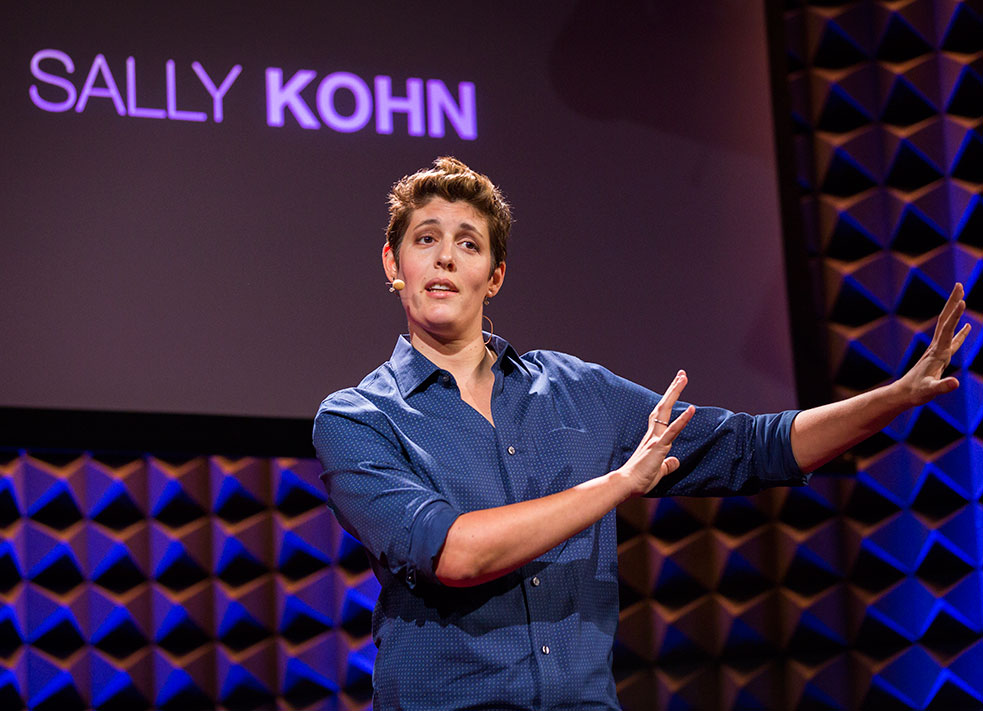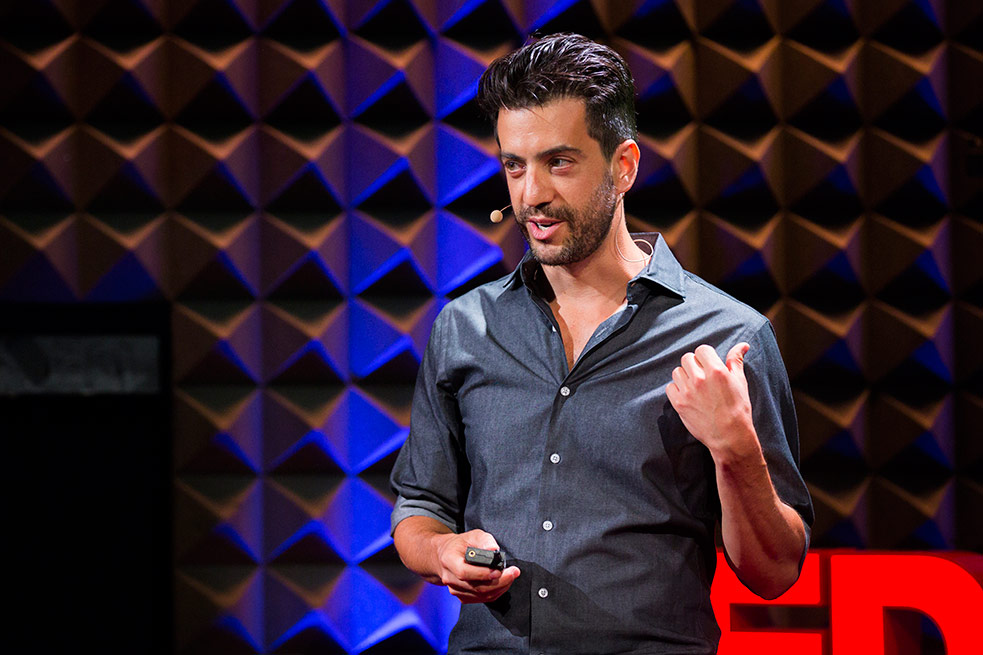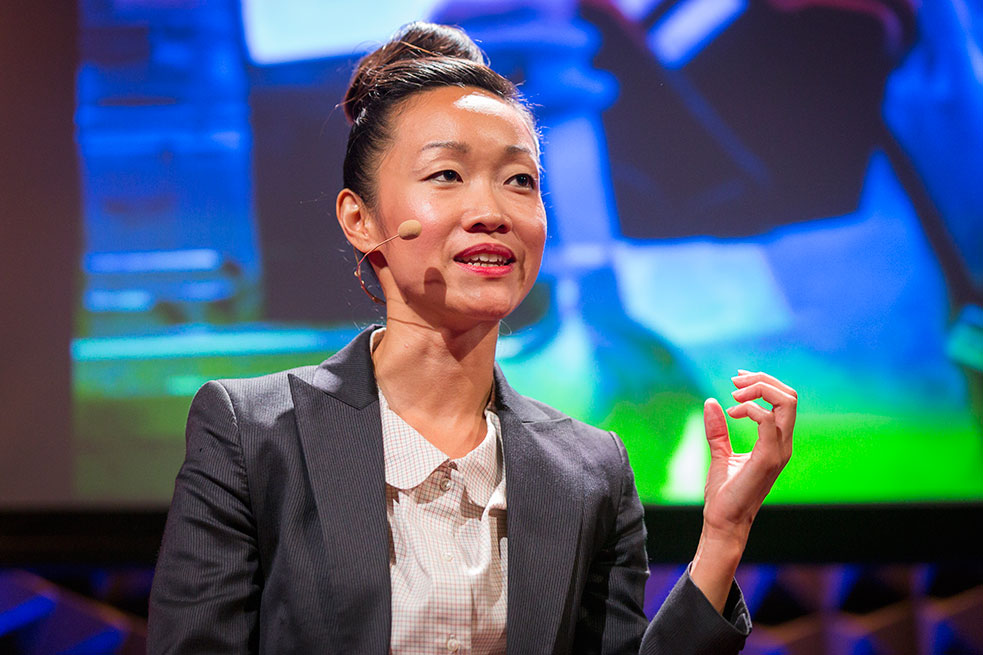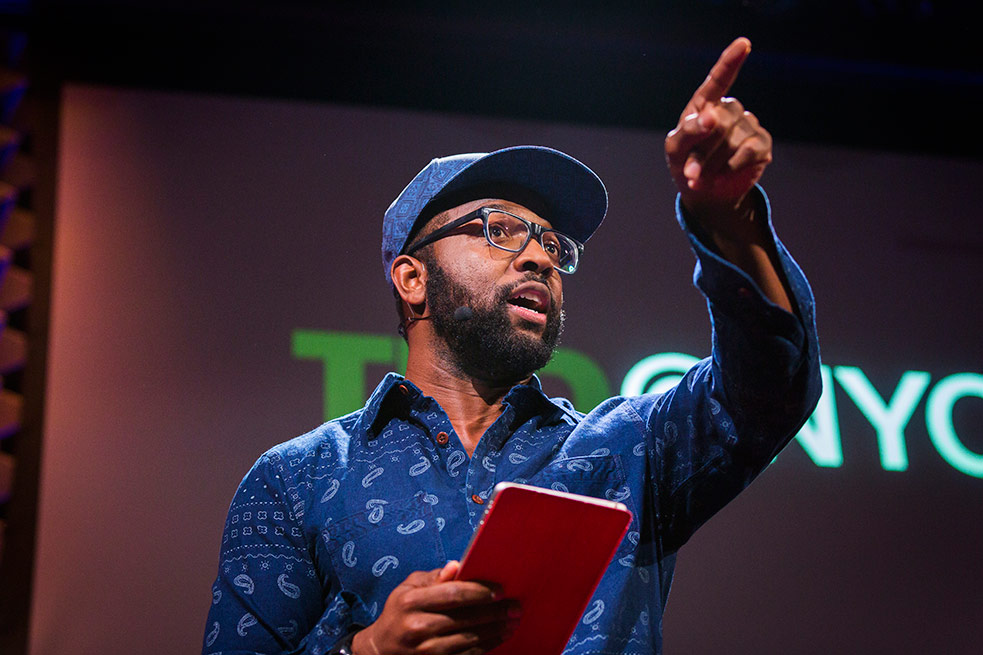
Sally Kohn opens TED@NYC with a plea for us to think of each tweet we write and each headline we click on as an act of media creation. Photo: Ryan Lash
TED@NYC is not your usual TED event. Hosted in a New York City club, speakers here—many of whom responded to an open audition call—give rapid-fire, five-minute talks. Below, a recap of each speaker who took the stage last night during this inspiring evening.
The internet can be a place of intelligent conversation, or a place of rumors and insults. Sally Kohn, once the liberal voice of Fox News and now a CNN contributor (and occasional Newt Gingrich debate partner), returns to the TED@NYC stage to deliver an important message: We can influence what we see online, because we are not just passive recipients of media. With everything we blog, everything we tweet and every link we click on, we are making media, she says. “We are the new editors,” she stresses. “We decide what gets attention.”
“Big oil broke my heart,” says Christine Bader, author of The Evolution of the Corporate Idealist. Bader worked at BP for nine years, believing deeply in the power of business to do good. But when the Deepwater Horizon Oil Rig exploded in the Gulf of Mexico, she became disillusioned. That’s when she had to start appreciating incremental progress. Inside every massive corporation, there’s an invisible army of idealists working to prevent disasters, she says, and they tackle the toughest issues at the heart of globalization, step by step, day by day. If we reward the responsible, honest and cautious behavior we want to see in business, we can move the needle, she says.
We live in an age of relentless self-promotion, but that culture is not without exception. David Zweig sings the praises of “Invisibles,” those with successful careers who haven’t made a name for themselves at all. There’s Jim Harding, the mind behind wayfinding, the art of guiding people through complex spaces with just the right signage font and aisle angle. There’s Dennis Poon, who’s engineered some of the world’s tallest skyscrapers without the public face of a Wright or Gehry, and Peter Stumpf, the piano technician for a symphony orchestra, whose name isn’t in the program but feels a part of a duet when the piano sounds right. These invisibles share a desire to remain outside the limelight, but Zweig believes that their stories are the antidote to a world that lives for likes and followers.
When children’s book author Jarrett Krosoczka visited his elementary school, he looked across the cafeteria. “There she was, my old lunch lady,” he says. Seeing the woman who used to happily serve him pizza ignited the idea for the Lunch Lady graphic novel series, in which hand-drawn heroes wield fishstick nunchucks and capture the bad guys in hairnets.The series took off, but even more meaningful to Krosoczka: his lunch lady felt like he’d validated her life’s work. It led Krosoczka to a new project—School Lunch Hero Day—to thank hard workers like her.
Next up is a speaker who had a lunch lady in her life very recently. Sara Sakowitz, an 18-year-old cancer researcher, is studying genetic methods to stop the spread of breast cancer. Her work focuses on shutting down the dangerous stage of metastasis by silencing important genes that normally block cancer progression. It’s a new therapy that could someday change the way we treat many types of cancer. As Sakowitz has developed and grown as a researcher, she’s realized that science always needs fresh perspectives and people brave enough to explore new directions. It’s time for a mindset shift, she says. If we rethink how we think, we can find more effective treatments.
Why does time seem to fly on some occasions and to creep by interminably on others? That question is the focus of Jordan Gaines Lewis’ side work in science writing. Cross-cultural studies have yielded surprisingly concrete conclusions, in the form of five key things that make time fly: (1) A lack of memorable events (think high school homecoming) (2) Time becoming short relative to how long you’ve lived (3) Actual biological signals within your body (4) A focus on boring routines and (5) Stress, because perceiving there to be too little time actually makes it seem like there’s even less of it. Armed with this information, the ways to slow time down are actually quite simple. Vary your routine, make plans for the future, and make a conscious effort to savor each moment.

Daniel Barasch left his job to work fulltime on The Lowline, the first underground park.
Daniel Barasch is building a park, complete with lush greenery, underneath the bustling sidewalks of New York City. The inversion of the Highline, this project is called The Lowline, and it will be built in an underground trolley terminal abandoned in 1948. By harvesting sunlight, concentrating it and reflecting it below ground, this park-in-the-works will be bright and beautiful—a football field-sized space where residents of the Lower East Side can gather year-round. This part is especially important to Barasch, as this is the neighborhood where his grandparents lived when they first immigrated to the United States. They may even have walked through that very trolley terminal.
Why do we love iced coffee, but sometimes cringe at the sight of someone wearing Google Glass? The answer, says Madison Maxey, lies with ergonomic design. The founder of CRATED, a fashion and tech company, is fascinated with the bond between human and object. She thinks that the future of wearable technology lies with objects that interact with us, ask us questions and predict what we want. If we fold design into the creative process, rather than applying it on top later, we might hit the sweet spot where we fall in love with our objects.
Around the world men are facing a dire problem: They believe they cannot dance. Benjamin Weston is here to help. The only dance step you need, he says, is the two-step. Step right and touch, step left and touch. The secret is that dancing isn’t really your moves at all. Pull your hands out of your pockets, stop hiding behind your drink, and give it some flavor — if the music is playful, be playful; if the music is aggressive, be aggressive. Dancing is just your presence, to a beat, insists Weston, as he shakes and shimmies on the stage.
The stories we’re told about love as kids lead us to believe that our perfect partner appears magically or by fate. Ty Tashiro, relationship psychologist and author of The Science of Happily Ever After, is here to tell us that’s not the case—and that these beliefs lead us to look for the wrong things in potential partners. As Tashiro found in his research, people tend to get their “first three wishes” in a partner, but too often they waste these wishes on good looks and wealth while the characteristics that really correlate to marital happiness are emotional stability, being exciting, and being kind. For couples that choose each other based on these criteria, marriage satisfaction stays far more stable over the long-term.
Our next speaker shares a deeply personal story of fatherhood and forgiveness. Growing up on the South Side of San Antonio in the 1980s, actor and writer Brian Luna struggled with poverty, homelessness and unemployment after his father was arrested for theft. Luna shares how he came to terms with his own shame about his father’s decisions. He was angry and frustrated, until one night, at 3 a.m., he visited his dad at work. They began the long, difficult journey of working through their challenges. “Shine a light on your story,” he says. “Let others know that outside the impossible walls of this shame, the air is breathable.”
“We’re all made of the same stuff in the same box,” says Dustin Yellin, who knows a thing or two about boxes. When the artist was eight years old, he buried a dollar bill, a pen and a fork in a box for aliens to find. In his later work, he filled layers of resin and glass with his own taxonomy of invented specimens — plants, insects and creatures like “Triptych,” his eerie and astounding homage to Hieronymous Bosch’s Garden of Earthly Delights that’s filled with cycloptic eyeballs, floating animal heads and Osama bin Laden. But the latest and largest of his boxes is “Pioneer Works,” which contains a physicist, a musician, a garden and a school, for starters. “We shake the box and people start hitting each other like particles,” he says.
The second session of the evening kicks off with the intricate and irresistible beats of Emily Wells. The classical violinist blends the traditional with the modern in a mesmerizing blend of strings, vocals and electronic rhythm. With a performance, she entranced the audience.
Joy Sun challenges organizations to nix the idea that “some good” is all we can hope for. With the belief that charity should empower rather than simply help, this TED Fellow works as the COO of GiveDirectly, which allows donors to transfer funds to people, ”cash given with no strings attached.” Sun admits that, at first, she assumed this was not the best model as people might actually need organizations to help them make good choices. But the evidence shows otherwise. So Sun asks: how good are organizations at allocating resources on behalf of the poor? To do the most good, she suggests, sometimes the best thing we can do is take a step back and give people the means to help themselves.
Nonprofit life is intense. Once upon a time, the former executive director of GLAAD, Joan Garry, was what her employees described as a venti — a Starbucks measurement of intensity. Her leadership style was making people sick — literally. After noticing an employee’s serious health condition, she learned three valuable lessons about managing the intensity and urgency of work: focus on what actually matters, be a real person who has fun, and be a champion of purpose, helping each employee find meaning and significance in their work. These are good tips to help you manage your job, no matter where you work.
Daniel Gareau and his team created a new microscope system that provides cellular imaging in whole tissue. They were excited about their breakthrough, and couldn’t wait for it to revolutionize skin cancer surgery. But when they presented their black-and-white contrast images to medical teams, they could see that they weren’t capturing the doctors’ interest. The images weren’t in the visual language that medical teams were used to, pink-and-purple dye stain that they had years of experience interpreting. As soon as they reorganized the tech to match those familiar visuals, the system started turning heads. “Tech won’t change medical practice with one inventor,” says Gareau. “It needs to spread.”

Molmol Kuo reveals her art that can, in essence, have a conversation with you. Photo: Ryan Lash
Artist Molmol Kuo creates objects that tell stories. At YesYesNo, she makes art that breaks the barriers between human and object in surprising and funny ways. With new media and a penchant for “doing weird things with electricity,” she’s designed water fountains and shoes that talk to you. And for London’s cultural expo, she created a series of balloons that ran 70 miles along Hadrian’s Wall and communicated user-generated messages through light.
Draped in a glittery, feathery explosion of stars and stripes, Taylor Mac sighs, “Aren’t you exhausted from ideas? This is a factory of ideas.” To pause the flow of speakers, judy (Mac’s preferred name) does some performance art, launching into “Snakeskin Cowboy” from judy’s upcoming 24-decade concert of the history of music. Determined to turn the room into “a queer junior high school dance,” judy asks the audience to stand up, find someone of the same sex, and hold on tight. Together, the room sways. “You have to go on a little longer than is appropriate,” judy says. “If you stop, Ted Nugent has won.”
Up next is cybersecurity expert Dave Weinstein, who thinks we need to reevaluate our approach to staying safe online. Rather than focusing on the vulnerabilities of the Internet, let’s think about the human decisions behind cyberattacks. Where does this desire to do harm come from? How can we create a system to mutually deter aggressive online behavior? If we focus on the humanity behind cyber, says Weinstein, we’ll have a safer online world.
Luigi Sorbara dreamed of being a professional athlete, but he knew he wasn’t strong enough and fast enough. So he settled for doing math in a windowless room. What he got was not a bad compromise: doing math in an NBA arena. Sorbara brings what he calls “the databall” to the Boston Celtics, taking the massive amounts of data recorded by six cameras trained on all 10 players, plus the ball, through every single game. How is that helpful? While Sorbara won’t reveal any Celtics secrets (especially not in New York), he shares some of what the Houston Rockets are doing with it: their data showed that the estimated shot value on a long two-pointer was actually lower than a three-pointer, so they changed their offense. Now 89 percent of their shots are either three-pointers or right at the rim.
Comedian Jill Shargaa speaks next, giving an awesome talk about the most awesome word: awesome. It’s overused, she says. Let’s fix that. She heeds us to put the awe back in awesome, because when we mix the mundane with the majestic, we take the power away from our lexicon. Some things that are actually awesome: the wheel! Pyramids! The Grand Canyon! Louis Daguerre! D-Day! Honey bees! The moon landing! Woodstock! Sharks! The Internet! What’s not awesome? Powerpoints.
Perry Barber didn’t become a female MLB umpire as a political act—her mother just told her that a Little League team was looking for an umpire, so she thought she’d give it a try. She’s passionate about encouraging other women to try it too, as there are currently zero female umpires in professional baseball—not because of discrimination, but because of inertia, she says. Umpiring is much more fun than it looks and it’s also a job that requires serious conflict resolution and communication skills. Staying composed in the middle of the chaos, diffusing potential violence—this is what makes umpiring meaningful. So ladies, get thee to umpire school.
“Am I going to die?” As an EMT, Matthew O’Reilly was hit with this question over and over. When someone has minutes left to live, and there is nothing medicine can do, O’Reilly has make a choice: “Do I tell the dying that they’re going to face death?” In these patients, O’Reilly sees above all inner peace and acceptance, so he has made the decision: “It is not my place to comfort the dying with my lies.” As people look for forgiveness, remembrance and significance in their lives, O’Reilly has come to value honest answers to hard questions.
Teacher and poet Clint Smith opens his poem “Silence” with a quote from Martin Luther King, Jr.: “In the end, we will remember not the words of our enemies, but the silence of our friends.” He continues exploring the danger and shame of silence in his own life — from one Lent in childhood when he gave up speaking, to awkward things unsaid at fundraising dinners — and in the lives of his students. In his classroom there are four ruling principles: (1) Read critically. (2) Write consciously. (3) Speak clearly. (4) Speak your truth. He does that with gusto in this spoken-word piece, avowing, “I will live every day as if there were a microphone tucked under my tongue.”
With quick wit and brutal honesty, Baratunde Thurston steps to the stage to wrap up the night. The comedian, author of How to Be Black and co-founder of Cultivated Wit shares observations, lessons learned, and some of his own commentary on the evening’s proceedings. From a solution to Sally Kohn’s clicking manifesto to a new name for Perry Barber’s profession to utter awe at Sara Sakowitz’s work, he was the perfect end to an — wait for it — awesome evening.

Baratunde Thurston closes out the night with sharp, funny observations. Photo: Ryan Lash
Liz Jacobs, Morton Bast, Olivia Cucinotta and Kate Torgovnick May all contributed to this piece.
Comments (5)